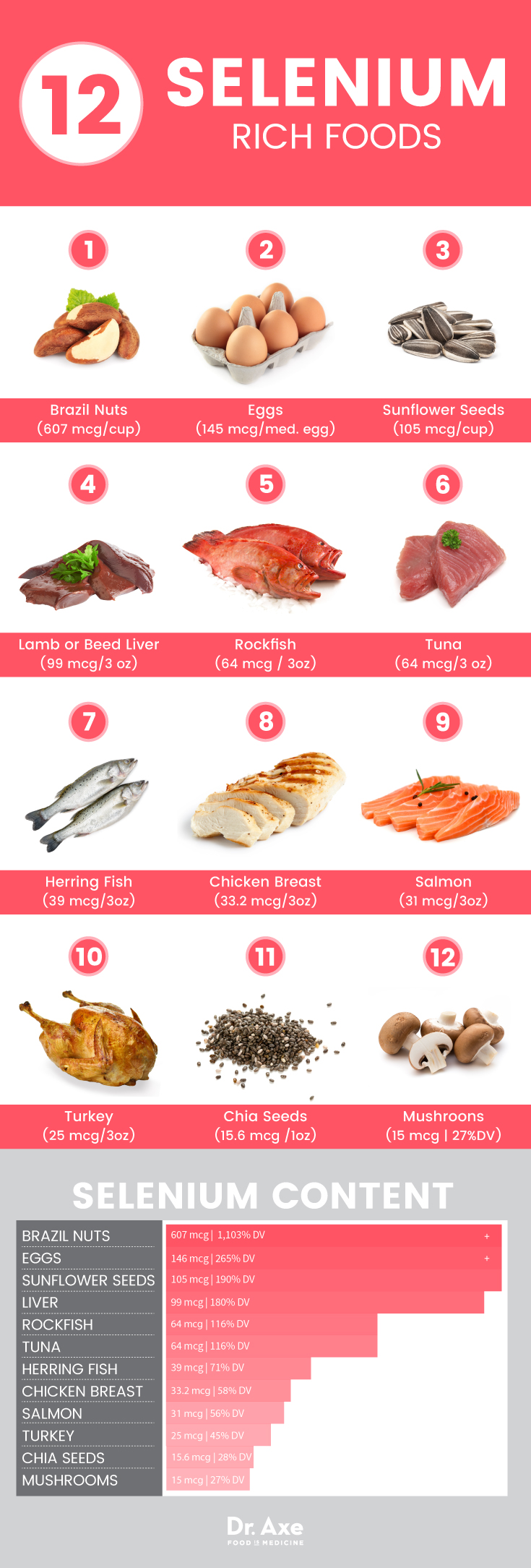candida-diet/chlorellavitamin-b12-benefits/

Best Sources of Selenium
Here are the top 12 foods naturally high in trace mineral selenium (percentages based on RDA of 55 mcg/day for adults):
- Brazil Nuts — 1 cup: 607 micgroams (1,1031 %
- Eggs — 1 medium egg: 146 micrograms (265 %)
- Sunflower Seeds — 1 cup: 105 micrograms (190 percent DV)
- Liver (from lamb for beef) — 3 ounces: 99 micrograms (180 percent DV)
- Rockfish — 3 ounces: 64 micrograms (116 percent DV)
- Tuna — 3 ounces: 64 micrograms (116 percent DV)
- Herring Fish — 3 ounces: 39 micrograms (71 percent DV)
- Chicken Breast — 3 ounces: 33.2 micrograms (58 percent DV)
- Salmon — 3 ounces: 31 micrograms (56 percent DV)
- Turkey — 3 ounces: 25 micrograms (45 percent DV)
- Chia Seeds — 1 ounce: 15.6 micrograms (28 percent DV)
- Mushrooms — 1 cup mixed: 15 micrograms (27 percent DV)

Causes of Selenium Deficiency
Selenium can be found in soil and from food sources. There are actually four naturally occurring types of the trace mineral selenium. The four natural states of selenium are elemental selenium, selenide, selenite and selenate.
Two types, selenate and selenite, are found predominately in water, whereas the other two types are the kinds found in soil and therefore in food sources. For humans, the primary pathway of consuming selenium is through food, followed by water and then by air. (10)
The content of selenium in soil differs a lot depending on the location. For example, certain studies show concern that parts of Europe and Africa have soil low in selenium levels and the populations living in those areas may be suffering from compromised immunity because of this.
There’s more evidence in other studies showing that a decline in blood selenium concentration is taking place in populations in parts of the U.K. and other European Union countries, which worries health experts. Health authorities worry about several potential health implications that can result due to a selenium deficiency.
One of the main concerns is that these populations will begin showing even higher increased rates of chronic disease that are prevalent in the U.S., such as cancer and heart disease.
Even in food sources, the amount of selenium is largely dependent on soil conditions that the food grew in — therefore even within the same food, levels of selenium can vary widely, and selenium benefits may be found in crops grown in certain locations more so than others.
Suffering from a selenium deficiency is correlated with an increased risk of mortality, poor immune function and cognitive decline, and the deficiency occurs when one or more specific selenoprotein is lacking. (11)
While the RDA for selenium for adults is 55 micrograms/daily, the average daily intake of selenium in the U.S. is believed to be 125 micrograms per day, which far meets the daily requirements. According to research, populations in the U.S. of the Eastern Coastal Plain and the Pacific Northwest have the lowest selenium levels due to the soil in those areas.
These populations average consuming 60 to 90 micrograms per day, which is still considered to be adequate intake but less than other populations where the soil is more selenium-rich.
Selenium deficiency and iodine deficiency are also considered common in areas affected by Kashin-Beck disease, a chronic bone disorder. (12)
Testing for Selenium Deficiency
If you have a condition that puts you at risk for selenium deficiency, you may want to have your levels tested to see if you can experience additional selenium benefits by taking a supplement. To find out your current selenium levels, you can have a blood or hair test done by your doctor.
However, a blood test will only show you the amount of selenium you’ve taken recently. Also, the accuracy of hair tests is not very consistent, since the mineral is stored differently throughout different organs and systems.
For example, your thyroid stores more selenium than anywhere else in the body because selenium plays a big part in metabolicprocesses.
